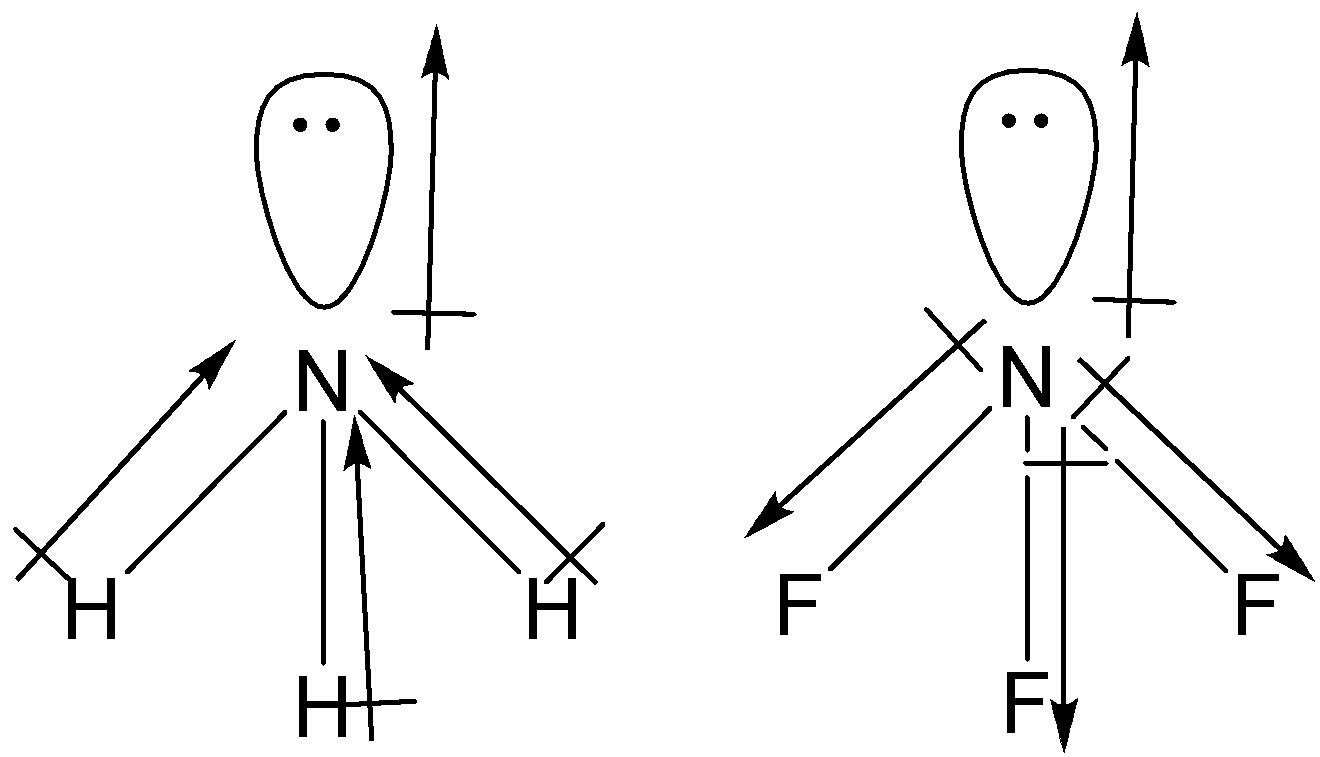
What is the correct dipole moment of $N{{H}_{3}}$ and $N{{F}_{3}}$ respectively?
(A)- $4.90\times {{10}^{-30}}$ C m and $0.80\times {{10}^{-30}}$ C m
(B)- $0.80\times {{10}^{-30}}$ C m and $4.90\times {{10}^{-30}}$ C m
(C)- $4.90\times {{10}^{-30}}$ C m and $4.90\times {{10}^{-30}}$ C m
(D)- $0.80\times {{10}^{-30}}$ C m and $0.80\times {{10}^{-30}}$ C m
Answer
574.8k+ views
Hint: Dipole moment is a measure of polarity of a bond. It is the product of the charges and the distance between partial charges. It is a vector quantity and its direction is always given from less electronegative atom to more electronegative atom.
It is generally expressed in debye (D) and 1 D = $3.33564\times {{10}^{-30}}$ C m.
Dipole moment of polar molecules containing lone pairs is the vector sum of dipole of lone pair and net dipole moments of bonds.
Complete answer:
Both $N{{H}_{3}}$ and $N{{F}_{3}}$ have trigonal pyramidal shape.

The dipole moment of lone pairs in $N{{H}_{3}}$ and $N{{F}_{3}}$ is away from nitrogen.
Dipole moment of $N{{H}_{3}}$
We know that nitrogen is more electronegative than hydrogen. Therefore, the dipole moment of $N-H$bond will be form H to N. The net dipole moment of three $N-H$ bond will add up to 1.4 D. As we know that 1 D = $3.33564\times {{10}^{-34}}$ C m.
Then, 1.4 D will be equal to $1.4\times 3.33564\times {{10}^{-30}}$ C m, i.e. $4.90\times {{10}^{-30}}$ C m.
Dipole moment of $N{{F}_{3}}$
Electronegativity of F is more than that of N, thus the direction of dipole moment of $N-F$ bond will be from F to N. As we can see that the direction of $N-F$ bond is opposite to that of the lone pair on N atoms. So, the net dipole moment of $N{{F}_{3}}$ has been found to be 0.24 D.
Multiplying 0.24 D with $3.33564\times {{10}^{-30}}$ C m, we get the dipole moment of $0.80\times {{10}^{-30}}$C m.
So, the correct answer is “Option A”.
Note: The dipole moment of lone pairs in $N{{H}_{3}}$ and $N{{F}_{3}}$ is away from nitrogen.
Dipole moment of $N{{H}_{3}}$
We know that nitrogen is more electronegative than hydrogen. Therefore, the dipole moment of $N-H$bond will be form H to N. The net dipole moment of three $N-H$ bond will add up to 1.4 D. As we know that 1 D = $3.33564\times {{10}^{-34}}$ C m.
Then, 1.4 D will be equal to $1.4\times 3.33564\times {{10}^{-30}}$ C m, i.e. $4.90\times {{10}^{-30}}$ C m.
Dipole moment of $N{{F}_{3}}$
Electronegativity of F is more than that of N, thus the direction of dipole moment of $N-F$ bond will be from F to N. As we can see that the direction of $N-F$ bond is opposite to that of the lone pair on N atoms. So, the net dipole moment of $N{{F}_{3}}$ has been found to be 0.24 D.
Multiplying 0.24 D with $3.33564\times {{10}^{-30}}$ C m, we get the dipole moment of $0.80\times {{10}^{-30}}$C m.
It is generally expressed in debye (D) and 1 D = $3.33564\times {{10}^{-30}}$ C m.
Dipole moment of polar molecules containing lone pairs is the vector sum of dipole of lone pair and net dipole moments of bonds.
Complete answer:
Both $N{{H}_{3}}$ and $N{{F}_{3}}$ have trigonal pyramidal shape.

The dipole moment of lone pairs in $N{{H}_{3}}$ and $N{{F}_{3}}$ is away from nitrogen.
Dipole moment of $N{{H}_{3}}$
We know that nitrogen is more electronegative than hydrogen. Therefore, the dipole moment of $N-H$bond will be form H to N. The net dipole moment of three $N-H$ bond will add up to 1.4 D. As we know that 1 D = $3.33564\times {{10}^{-34}}$ C m.
Then, 1.4 D will be equal to $1.4\times 3.33564\times {{10}^{-30}}$ C m, i.e. $4.90\times {{10}^{-30}}$ C m.
Dipole moment of $N{{F}_{3}}$
Electronegativity of F is more than that of N, thus the direction of dipole moment of $N-F$ bond will be from F to N. As we can see that the direction of $N-F$ bond is opposite to that of the lone pair on N atoms. So, the net dipole moment of $N{{F}_{3}}$ has been found to be 0.24 D.
Multiplying 0.24 D with $3.33564\times {{10}^{-30}}$ C m, we get the dipole moment of $0.80\times {{10}^{-30}}$C m.
So, the correct answer is “Option A”.
Note: The dipole moment of lone pairs in $N{{H}_{3}}$ and $N{{F}_{3}}$ is away from nitrogen.
Dipole moment of $N{{H}_{3}}$
We know that nitrogen is more electronegative than hydrogen. Therefore, the dipole moment of $N-H$bond will be form H to N. The net dipole moment of three $N-H$ bond will add up to 1.4 D. As we know that 1 D = $3.33564\times {{10}^{-34}}$ C m.
Then, 1.4 D will be equal to $1.4\times 3.33564\times {{10}^{-30}}$ C m, i.e. $4.90\times {{10}^{-30}}$ C m.
Dipole moment of $N{{F}_{3}}$
Electronegativity of F is more than that of N, thus the direction of dipole moment of $N-F$ bond will be from F to N. As we can see that the direction of $N-F$ bond is opposite to that of the lone pair on N atoms. So, the net dipole moment of $N{{F}_{3}}$ has been found to be 0.24 D.
Multiplying 0.24 D with $3.33564\times {{10}^{-30}}$ C m, we get the dipole moment of $0.80\times {{10}^{-30}}$C m.
Recently Updated Pages
Master Class 11 Social Science: Engaging Questions & Answers for Success

Master Class 11 Physics: Engaging Questions & Answers for Success

Master Class 11 Maths: Engaging Questions & Answers for Success

Master Class 11 Economics: Engaging Questions & Answers for Success

Master Class 11 Computer Science: Engaging Questions & Answers for Success

Master Class 11 Chemistry: Engaging Questions & Answers for Success

Trending doubts
What is meant by exothermic and endothermic reactions class 11 chemistry CBSE

10 examples of friction in our daily life

One Metric ton is equal to kg A 10000 B 1000 C 100 class 11 physics CBSE

1 Quintal is equal to a 110 kg b 10 kg c 100kg d 1000 class 11 physics CBSE

Difference Between Prokaryotic Cells and Eukaryotic Cells

Discuss the various forms of bacteria class 11 biology CBSE




